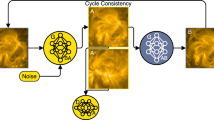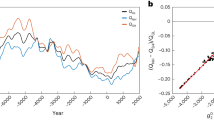Abstract
THERE is evidence which indicates1–4 that the occurrence rate of meteor radar echoes varies inversely with solar cycle activity, this phenomenon can be explained5–6 by a long-term variation in the atmospheric density gradient at the meteor ablation level. Inferred changes in the atmospheric properties are attributed to a long-term variation in the solar EUV radiation. Although the long-term, solar cycle changes in radar-determined meteor rates show an inverse correlation with sunspot numbers and other measures of solar activity, such correspondence is not readily evident in the day-to-day meteor radar data. One reason for this is the inability of most solar activity indices to measure the relevant solar parameters involved in short-term solar–terrestrial effects. The study of solar-influenced meteor rate changes on a time scale of days has, therefore, not received adequate attention. Evidence for a short-term dependence of meteor radar rates on geomagnetic activity and solar corpuscular radiation is presented here.
This is a preview of subscription content, access via your institution
Access options
Subscribe to this journal
Receive 51 print issues and online access
$199.00 per year
only $3.90 per issue
Buy this article
- Purchase on SpringerLink
- Instant access to full article PDF
Prices may be subject to local taxes which are calculated during checkout
Similar content being viewed by others
References
Lindblad, B. A. Space Res. 7, 1029–1043 (1967).
Lindblad, B. A. in Physics and Dynamics of Meteors (eds Kresak, L. & Millman, P. M.) 50–62 (Reidel, Dordrecht, 1968).
Hughes, D. W. Nature 252, 191–192 (1974).
Ellyett, C. D. J. geophys. Res. 82, 1455–1462 (1977).
Lindblad, B. A. Nature 259, 99–101 (1976).
Hughes, D. W. Space Res. 16, 333–339 (1976).
Lindblad, B. A. Smithson Contr. Astrophys. 11, 171–180 (1967).
Wilcox, J. M. et al. Science 180, 185–186 (1973).
Wilcox, J. M. et al. Nature 255, 539–540 (1976).
Reiter, R. J. atmos. ten. Phys. 38, 503–510 (1976).
Svalgaard, L. Interplanetary Sector Structure, 1947–75 (SUIPR Rep. no. 648, Inst. for Plasma Res,. Standford, 1976).
Wilcox, J. M. & Colburn, D. S. J. geophys. Res. 77, 751–756 (1972).
Shapiro, R. J. geophys. Res. 79, 289–291 (1974).
Jacchia, L. G. Nature 183, 526–527 (1959).
Jacchia, L. G. et al. J. geophys. Res. 72, 1423–1434 (1967).
Roemer, M. Space Res. 11, 965–974 (1971).
Ching, B. K. J. geophys. Res. 76, 197–201 (1971).
Cole, K. D. Austral. J. Phys. 15, 223–235 (1962).
Rostoker, G. & Fälthammar, C. G. J. geophys. Res. 72, 5853–5863 (1967).
Schatten, K. H. & Wilcox, J. M. J. geophys. Res. 72, 5185–5191 (1967).
Wilcox, J. M. J. geophys. Res. 73, 6835–6836 (1968).
Berthelier, A. & Guerin, C. Space Res. 13, 661–667 (1973).
Sawyer, C. J. geophys. Res. 81, 2437–2441 (1976).
Sawyer, C. & Haurwitz, M. J. geophys. Res. 81, 2435–2436 (1976).
Author information
Authors and Affiliations
Rights and permissions
About this article
Cite this article
LINDBLAD, B. Meteor radar rates, geomagnetic activity and solar wind sector structure. Nature 273, 732–734 (1978). https://doi.org/10.1038/273732a0
Received:
Accepted:
Issue date:
DOI: https://doi.org/10.1038/273732a0



